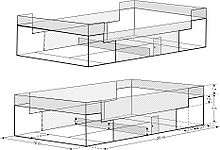Padel (sport)
Padel is a racquet sport. It is different from the sport known in the US and Canada as paddle tennis.
 Padel players on outdoor padel courts | |
| Highest governing body | International Padel Federation (IPF) |
|---|---|
| Nicknames | Paddle (US, Canada) |
| First played | 1969, Acapulco, Mexico |
| Characteristics | |
| Contact | No |
| Team members | Singles, Usually Doubles |
| Mixed gender | Separate competitions (mixed sometimes in leagues) |
| Type | Racquet sport |
| Equipment | Padel Racquet, Padel Ball and Padel Court. |
| Venue | Outdoor or indoor Padel Court |
| Presence | |
| Country or region | Worldwide |
| Olympic | No |
| Paralympic | No |
Padel is typically played in doubles on an enclosed court a third the size of a tennis court. Scoring is the same as normal tennis and the balls used are similar but with a little less pressure. The main differences are that the court has walls and the balls can be played off them in a similar way as in the game of squash and that solid, stringless bats are used. The height of the ball being served must be at or below the waist level.
Padel is not to be confused with platform tennis, a winter and summer sport typically played at country clubs in the US and Canada, with courts heated from below to eliminate snow and water. The court, rules and styles of play are very different.
History
The sport was invented in Acapulco, Mexico, by Enrique Corcuera in 1969.[1] It is currently most popular in Spain, Mexico and Andorra as well as Hispanic American countries such as Argentina, although it is now beginning to spread rapidly across Europe and other continents.
Padel Pro Tour (PPT)[2] was the professional padel circuit which was created in 2005 as a result of the agreement between a group of organizers of matches of padel and Association of Professional Players of Pádel (AJPP) and the Spanish Feminine Association of Pádel (AFEP). Nowadays, the most important padel circuit is World Padel Tour (WPT)[3], which started in Spain though it has already reached international expansion. In 2014 WPT has traveled to Portugal, Argentina and Dubai.
The sport's popularity along the Costa del Sol in southern Spain and the Algarve in southern Portugal has exposed it to a large number of British visitors, leading to an increased popularity of the sport in the UK and a launch of the UK Padel Federation in 2011.
United States of America
The US Padel Association[4] was founded in Chattanooga, Tennessee in 1993, and opened two courts in the Chattanooga area. The American Paddle Association was formed in 1995 and built its first courts at a private club in Houston, Texas for exhibition games. The first public courts opened in Miami, Florida in 2009, and several clubs have opened nearby, as well as in Los Angeles, since then.
Egypt
In 2014, Mohamed Atef, Mohamed Saada, and Amir El Samahy introduced the sport to the country with the collaboration of technicians from Spain.[6] The first court was built in Katameya Heights in New Cairo. More courts have been built since and the sport has gained in popularity since its introduction.
The court

Padel rules[7] states that the playing field should be a rectangle 10 metres (32 ft 10 in) wide and 20 metres (65 ft 7 in) long (with a 0.5% tolerance), enclosed by walls. At the middle of the playing field there will be a net dividing the court in two, the net has a maximum height of 88 cm in the center raising to 92 centimetres (36 in) at sides (with a 0.5 centimetres (1⁄5 in) tolerance).[8]
The back walls should be 3 metres (9 ft 10 in) high covering the entire back of the field and the side walls should be 3 metres (9 ft 10 in) high and 2 metres (6 ft 7 in) long ending on another wall 2 metres (6 ft 7 in) high and 2 metres (6 ft 7 in) long (known as step-type, see picture). The diagonal-type side wall is also accepted, instead of a step, it runs as straight line between the two heights of the side wall. The rest of the court is closed using a metallic mesh also 3 metres (9 ft 10 in) high, the wall closed sides can also have a metallic mesh up to 1 metre (3 ft 3 in) tall.
The service lines are placed 3 metres (9 ft 10 in) before the back wall and there will be also another line in middle that divides the central rectangle in half. All lines have a 5-centimetre (2 in) width and should be clearly visible.
The minimum height between the playing field and an obstacle (for e.g. the ceiling) is 6 metres (19 ft 8 in).
Facts

- Players: Singles use 6 by 20 metres (19 ft 8 in by 65 ft 7 in) instead of 10 by 20 metres (32 ft 10 in by 65 ft 7 in).
- Serves: Both first and second serves must be underhand.
- Score: Scoring method is the same as in tennis.
- Ball: Very similar to tennis balls. Tennis balls are sometimes used.
- Padel Bat: Solid with no strings. May be perforated.
- Walls: Walls are used as part of the game.
See also
References
- "History of Padel". Retrieved 2020-07-01.
- "Padel Pro Tour". Retrieved 2020-07-01.
- "World Padel Tour". Retrieved 2020-07-01.
- "US Padel Association". Retrieved 2020-07-01.
- "Beginning and development of padel in Asia". Retrieved 2020-07-01.
- "Bored and Clueless? Go Padel! - What Women Want". 2019-06-03. Archived from the original on 2019-06-03. Retrieved 2019-12-29.
- "The Rules of Padel". Retrieved 2020-07-01.
- "Padel Court Dimensions". Retrieved 2020-07-01.